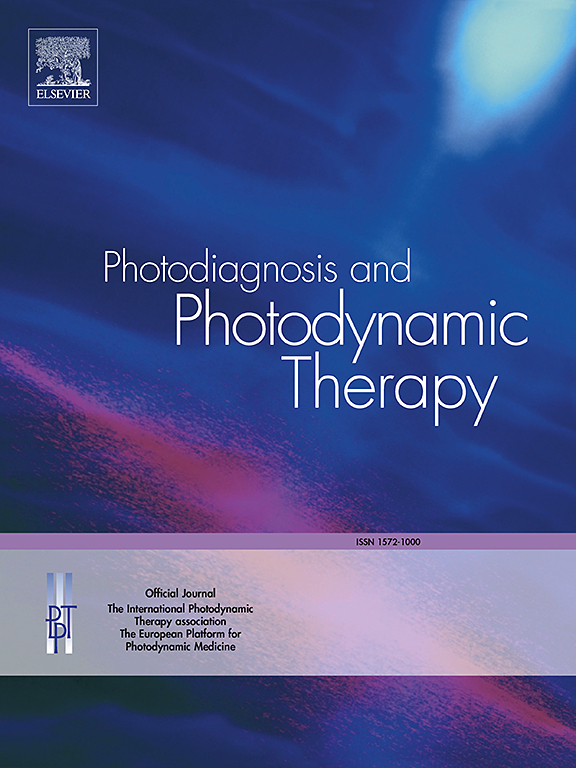重复光动力疗法辅助SRP治疗II类功能的疗效评价。
IF 3.1
3区 医学
Q2 ONCOLOGY
引用次数: 0
摘要
目的:本研究旨在评估重复光动力治疗(PDT)与牙周刮治和牙根刨平(SRP)联合治疗是否能为II类分形受累的牙齿提供额外的短期临床益处。材料和方法:这项单中心随机对照试验招募了27例患者(85个II类FI部位),随机分配在基线、1周和2周接受刮治和根治(SRP)和辅助光动力治疗(PDT) (A组)或单独接受SRP (B组)。每次光动力治疗包括将0.1 mg/mL亚甲基蓝作为光敏剂注射到牙周袋中,然后用660±10 nm波长的激光以160-220 mW的功率照射60秒。评估临床结果(探诊出血[BOP%]、探诊深度[PD]、临床附着丧失[CAL])和龈沟液(GCF)生物标志物(IL-4、IL-6)。通过16S rRNA测序分析龈下微生物群,同时患者报告的结果(PROs)包括视觉模拟量表(VAS)和口腔健康影响(OHIP-14)。结果:3个月随访时,A组BOP%明显低于对照组(33.33% vs 55.81%;p0.05)。GCF分析显示,时间 × 组细胞因子表达显著互作(p0.05)。然而,A组口腔健康相关生活质量明显改善,OHIP-14总分(15.88±5.19)低于B组(18.12±5.09);结论:重复pdt辅助的SRP可促进II类FI部位的短期软组织愈合,调节炎症相关细胞因子和龈下微生物群,减少心理不适,而不会延长治疗疼痛、持续时间或疲劳。本文章由计算机程序翻译,如有差异,请以英文原文为准。
Evaluation of the therapeutic effect of repeated photodynamic therapy-assisted SRP treatments on class II furcation
Objective
This study aims to evaluate whether repeated photodynamic therapy (PDT) ad-junctive to periodontal scaling and root planing (SRP) provides additional short-term clinical benefits for teeth with class II furcation involvement (FI).
Materials and methods
This single-center randomized controlled trial enrolled 27 patients (85 Class II FI sites), randomly allocated to receive either scaling and root planing (SRP) with adjunctive photodynamic therapy (PDT) at baseline, 1, and 2 weeks (Group A) or SRP alone (Group B). Each photodynamic therapy session involved injecting 0.1 mg/mL methylene blue as a photosensitizer into the periodontal pocket, followed by irradiation with a 660±10 nm wavelength laser at a power of 160-220 mW for 60 s. Clinical outcomes (bleeding on probing [BOP %], probing depth [PD], clinical attachment loss [CAL]) and gingival crevicular fluid (GCF) biomarkers (IL-4, IL-6) were assessed. Subgingival microbiota was analyzed via 16S rRNA sequencing, while patient-reported outcomes (PROs) included Visual Analog Scale (VAS) and oral health impact (OHIP-14).
Results
At the 3-month follow-up, Group A demonstrated significantly lower BOP % (33.33 % vs. 55.81 %; p<0.05) and PD reduction (1.26±0.62 mm vs. 0.95±0.65 mm; p<0.05) compared to Group B. However, no significant intergroup differences were observed in CAL (p>0.05). Analysis of GCF revealed a significant time × group interaction in cytokine expression (p<0.001), with Group A showing more favorable inflammatory modulation. Microbiological assessment indicated a marked reduction in periodontal pathogens and improved microbial diversity in Group A (p<0.05). Patient-reported outcomes (PROs) demonstrated comparable therapeutic pain perception and postoperative fatigue between groups (VAS: p>0.05). However, Group A showed significantly better oral health-related quality of life, as evidenced by lower OHIP-14 total scores (15.88±5.19) compared to Group B (18.12±5.09; p<0.05).
Conclusions
Repeated PDT-assisted SRP enhances short-term soft tissue healing in Class II FI sites, modulates inflammation-related cytokines and subgingival microbiota, and reduces psychological discomfort without prolonging perceived treatment pain, duration or fatigue.
求助全文
通过发布文献求助,成功后即可免费获取论文全文。
去求助
来源期刊

Photodiagnosis and Photodynamic Therapy
ONCOLOGY-
CiteScore
5.80
自引率
24.20%
发文量
509
审稿时长
50 days
期刊介绍:
Photodiagnosis and Photodynamic Therapy is an international journal for the dissemination of scientific knowledge and clinical developments of Photodiagnosis and Photodynamic Therapy in all medical specialties. The journal publishes original articles, review articles, case presentations, "how-to-do-it" articles, Letters to the Editor, short communications and relevant images with short descriptions. All submitted material is subject to a strict peer-review process.
 求助内容:
求助内容: 应助结果提醒方式:
应助结果提醒方式:


